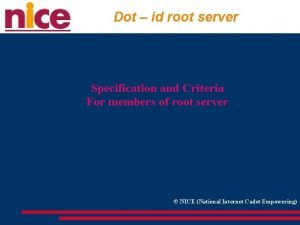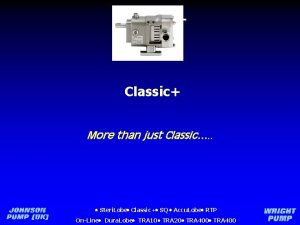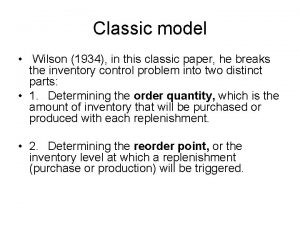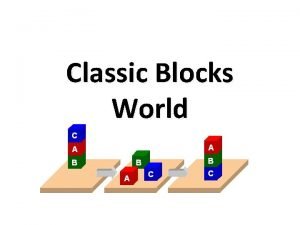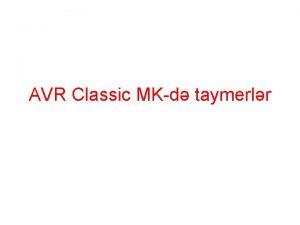A dot com classic Govworks com The dot
















- Slides: 16

A dot com classic Govworks. com

The “dot com” period is now seen as an historical aberration, the subject of a market phenomenon where the technologies behind e. Commerce applied in innovative ways sparked enormous enthusiasm amongst investors who were afraid to miss the “next big thing”.

It was a classic case of market economics: a huge demand for stocks of “dot com” companies, but very few that were actually listed with the stock exchanges and available to investors. The result was a spectacular run-up of prices of those companies whose stock was available, and a blizzard of concept pitches, with dubious business plans, designed to gather money from venture capitalists.

Dot companies emerged by the hundreds, thousands even, and were characterized by dizzyingly rapid growth. One in particular can be seen as the “poster child” example of a dot company, where a great idea took off, but ultimately fizzled as it ran out of time and money to deliver on the concept.

That company was gov. Works. com, and the reason it became so famous is that a documentary film team chronicled it from the moment of its inception to its final failure. The story of gov. Works. com is told in the film “Startup. com”, which received an unusually successful (for a documentary) release and widespread distribution.

gov. Works as a concept presented a classic Internet win-win scenario: vastly improved services at substantially lower cost, with less hassle for everyone involved. The premise for gov. Works was simple: provide citizens with easy access to their local and state government institutions for services ranging from filing for building permits to paying parking fines. The market was huge and the potential to provide high quality of service to a notoriously inefficient sector was breathtaking.

Unlike many dot com operations, this one had real economic viability. So what went wrong? From the film, one could find the following:

• the company grew too fast, from 2 to over 250 employees in about sixteen months; • they underestimated the time needed to build the core of the system; • the need to raise capital took tremendous time and energy; • success in raising money also brought a loss of control as outsiders gained control of the company’s board of directors;

• the gov. Works founders were overly optimistic in their expectations of income from clients; • they ran out of time and money; • fundamental mistakes in execution were made by the young, inexperienced founders.

Tom Herman was a co-founder of gov. Works, and served as its Chief Technology Officer. Q: If you were to do it over, as CTO, what would you do differently?

“The areas where I was the weakest were in managing the outside vendor and managing the expectations of the gov. Works non-technical resources (the CEO and other executives). If I were doing it again, I would have been more assertive with the vendor and from earlier on in the process demanded people on our team w/ more experience. In fact, I wouldn’t have chosen the vendor we did because they didn’t show me people who would be on my team that I felt brought the specific skills/experience that we needed. ”

“The other major thing I would have done differently is to have been more rigid about requiring specifications for projects before the engineering team took them on and less flexible about allowing changes. We tried to do too much at the same time and more importantly we often changed the goals at the last second. ”

“Change control is critical and I managed it poorly. This is really part and parcel with poor expectation management with my co-executives. It was hard for me to say “no” to last-minute change proposals and “feature-creep” when I knew the right answer was “no”. It was a go-go time when all things seemed possible, and it was difficult to stand in the way of such unrestrained optimism. I wanted to please people too much. ”

… what happened to the company? “We ran out of money and under distress sold the company to a subsidiary of First Data Corporation. The purchaser required that gov. Works file Chapter 11 protection before the acquisition was completed to eliminate all of the contingent liabilities. An indication that we were right about the prospects can be seen by the fact that we created is still running, and growing profitably under the new brand name, gov. One Solutions. The founders are no longer a part of it and made no financial gain from the sale of the company. ”

Q: Based upon your experiences with the new company, what are the most common mistakes made by crash-andburn dot com operations?

"Too rapid of growth, business plans that don’t address “mass problems”, and poor execution. For a startup to make sense it’s got to apply a scalable technological solution to a “mass problem” (i. e. , one that a lot of people KNOW they have). The product has to have a high margin and the company has to have the expectation of being profitable in a short amount of time so it can either stand alone or be bought for a premium. ”
 Tom herman govworks
Tom herman govworks Running header
Running header Dậy thổi cơm mua thịt cá
Dậy thổi cơm mua thịt cá Cơm
Cơm Id root
Id root Open dot and closed dot on a graph
Open dot and closed dot on a graph Java vs dotnet
Java vs dotnet Thế nào là hệ số cao nhất
Thế nào là hệ số cao nhất ưu thế lai là gì
ưu thế lai là gì Sơ đồ cơ thể người
Sơ đồ cơ thể người Tư thế ngồi viết
Tư thế ngồi viết Môn thể thao bắt đầu bằng chữ đua
Môn thể thao bắt đầu bằng chữ đua Cái miệng nó xinh thế
Cái miệng nó xinh thế Hát kết hợp bộ gõ cơ thể
Hát kết hợp bộ gõ cơ thể Cách giải mật thư tọa độ
Cách giải mật thư tọa độ Tư thế ngồi viết
Tư thế ngồi viết Voi kéo gỗ như thế nào
Voi kéo gỗ như thế nào




